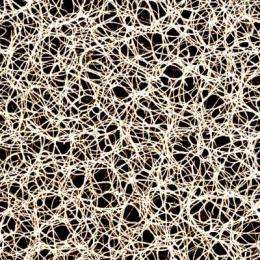Muscle filaments make mechanical strain visible

Plastics-based materials have been in use for decades. But manufacturers are facing a serious hurdle in their quest for new developments: Substantial influences of the microscopic material structure on mechanical material properties cannot be observed directly. The synthetic polymer molecules are simply too small for microscopic observation in mechanical experiments. A team of physicists led by professor Andreas Bausch of the Technische Universitaet Muenchen (TUM, Germany) has now developed a method that allows just these kinds of measurements. They present their results in Nature Communications.
When polyethylene film is strongly stretched, it becomes more tear-resistant. This makes shopping bags significantly more resilient. The effect is ascribed to a reorganization of polymer chains. Some elastic polymers get softer with frequently recurring stress. This phenomenon was named the Mullins effect after its discoverer. However, what exactly the polymer chains do when subjected to mechanical stress has so far not been sufficiently understood. One reason for this is that synthetic polymers are too small to be observed using microscopy methods during mechanical stress experiments. An improved understanding of the processes on a molecular level would save a lot of time and money in the development of new plastics.
Nature, too, takes advantage of the mechanical properties of polymers: Biological polymers give cells their stability and play a decisive role when they carry out their complex functions. Professor Andreas Bausch and his team used the muscle filament protein actin to build a new polymer network. The actin filaments are visible under a fluorescence microscope. This allowed the scientists to directly observe the movements of the individual filaments when mechanical stress was applied to the material.
By simultaneously using a rheometer, which is used to study the mechanical properties of materials, and a confocal microscope, the scientists were able to study the behavior of the actin network during mechanical deformation and to film it in three dimensions.
In their studies, published in the online journal Nature Communications, the scientists successfully demonstrated that their model system sheds light not only on the molecular-level processes behind the Mullins effect, but also the opposite effect, which renders material tougher as a result of repeated stress.
The cause for the change in mechanical properties is extensive reorganization in the network structure, which was now observed directly for the first time. In the future, this model will help physicists to better understand changes in the properties of other materials, too.
More information: Cyclic hardening in bundled actin networks, K. M. Schmoller, P. Fernández, R. C. Arevalo, D. L. Blair und A. R. Bausch, Nature Communications, Vol. 1, 134, 7 December 2010 – DOI:10.1038/ncomms1134
Provided by Technische Universitaet Muenchen
















